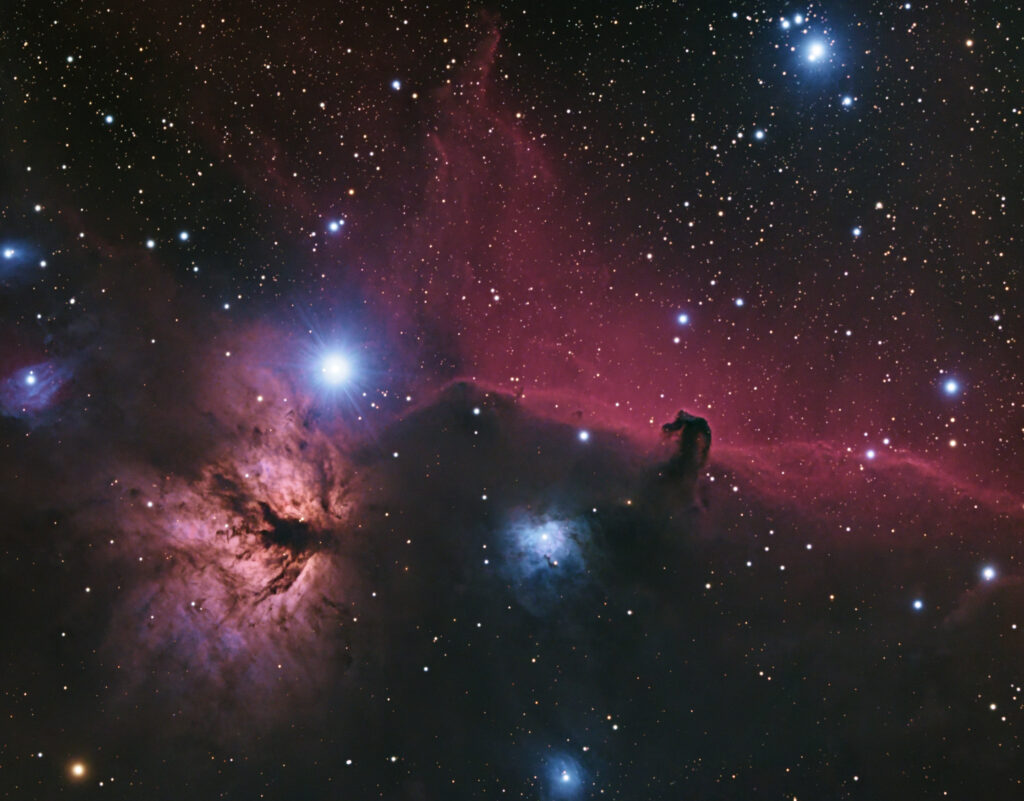A contribution by Werner Wöhrmann und Dr. Gerold Holtkamp March 22, 2024
The closest active star-forming region to Earth is located in the constellation Orion in the so-called Horsehead Nebula. Over the past two decades, a great deal of research has been done to understand its structure and the mechanisms at work within it.
The Horsehead Nebula in the Orion constellation is probably one of the most famous objects in the sky among astronomers. From our perspective, the relatively dark structure is clearly visible in front of the luminous H II region IC434, which runs north-south near the Orion belt star Alnitak. However, it is also physically part of IC434.

The bright star at the top right is Sigma Orionis. The bright star to the left of center is the belt star Alnitak. Below it is NGC2024, the so-called Flame Nebula.
The first known mention of the distinctive, glowing area comes from Wilhelm Herschel. He gave it the name Object No. 25 in 1811. The Horsehead Nebula itself was first identified on a photographic plate by Williamina Paton Stevens Fleming in 1888 [1]. It soon became clear that this was not an area without stars, but a real object made of dust and gas. That is why the Horsehead Nebula has been designated B33 in Barnard's catalog since 1919 [2].
This accumulation of interstellar gas is not only interesting because of its appearance, which happens to be so striking for us on Earth. In fact, over the last two decades, thanks to improved technical capabilities, a lot of research has been devoted to exploring the processes and structure of this object.
B33 is the closest of the known photodissociation regions* to Earth. In these areas, neutral gas (mostly hydrogen) and dust are compressed by radiation from a gas cloud that is itself ionized by UV radiation from massive young stars. This often creates dense columnar structures, sometimes referred to as elephant trunks because of their appearance. Whether shock fronts, which arise when the gas in the H II region hits the surrounding gas, also play a role here is still under discussion. Magnetic fields also play a role within the structure [3].
The star Sigma Orionis is considered to be the powerful UV source that ionizes the gas cloud IC434. It is a massive, radiation-intensive class OB star that belongs to a multiple system. Its distance from us is given as 1265 +/- 4.3 light years, while the distance from B33 to us on Earth is said to be around 1300 light years. This is thought to be close enough to trigger the formation of young stars. The total mass of the Horsehead Nebula is about 27 solar masses [3] [4].
Since 1984, young stars have been searched for in the Horsehead Nebula. To do this, one observes in the infrared spectral range, which allows one to penetrate much deeper into areas hidden from optical observation. Several strong infrared sources have been found, which may be young stars in the process of formation [3]. Both the EUCLID space telescope and the James Webb telescope, which operates in the infrared, will bring many exciting insights into the exploration of this star formation region in the Horsehead Nebula [5] [6].
* Photodissociation or photolysis is the splitting of molecules by high-energy radiation such as UV light. The intense, high-energy radiation and the stellar wind of a star - young massive stars are particularly relevant here - affect the surrounding interstellar medium, consisting largely of HII, and, in addition to photodissociation, also cause structure formation.
<-- Back to the Orion overview article
Sources:
[1] Edward Charles Pickering „Detection of new nebulae by photography“ in
[2] Pound, M. W., Reipurth, B. & Bally, J., The Astronomical Journal, 125:2108 (15pp), 2003 April
[5]https://www.esa.int/Science_Exploration/Space_Science/Euclid/Euclid_s_view_of_the_Horsehead_Nebula